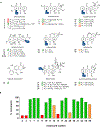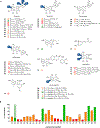Biochemical and Structural Studies of the Carminomycin 4- O-Methyltransferase DnrK
- PMID: 38412432
- PMCID: PMC11623920
- DOI: 10.1021/acs.jnatprod.3c00947
Biochemical and Structural Studies of the Carminomycin 4- O-Methyltransferase DnrK
Abstract
Structural and functional studies of the carminomycin 4-O-methyltransferase DnrK are described, with an emphasis on interrogating the acceptor substrate scope of DnrK. Specifically, the evaluation of 100 structurally and functionally diverse natural products and natural product mimetics revealed an array of pharmacophores as productive DnrK substrates. Representative newly identified DnrK substrates from this study included anthracyclines, angucyclines, anthraquinone-fused enediynes, flavonoids, pyranonaphthoquinones, and polyketides. The ligand-bound structure of DnrK bound to a non-native fluorescent hydroxycoumarin acceptor, 4-methylumbelliferone, along with corresponding DnrK kinetic parameters for 4-methylumbelliferone and native acceptor carminomycin are also reported for the first time. The demonstrated unique permissivity of DnrK highlights the potential for DnrK as a new tool in future biocatalytic and/or strain engineering applications. In addition, the comparative bioactivity assessment (cancer cell line cytotoxicity, 4E-BP1 phosphorylation, and axolotl embryo tail regeneration) of a select set of DnrK substrates/products highlights the ability of anthracycline 4-O-methylation to dictate diverse functional outcomes.
Conflict of interest statement
The authors declare no competing financial interest.
Figures





Similar articles
-
O-Methylation of flavonoids using DnrK based on molecular docking.J Microbiol Biotechnol. 2007 Dec;17(12):1991-5. J Microbiol Biotechnol. 2007. PMID: 18167447
-
Crystal structure of a ternary complex of DnrK, a methyltransferase in daunorubicin biosynthesis, with bound products.J Biol Chem. 2004 Sep 24;279(39):41149-56. doi: 10.1074/jbc.M407081200. Epub 2004 Jul 24. J Biol Chem. 2004. PMID: 15273252
-
Production of a new hybrid anthracycline 4-O-methylepelmycin by heterologous expression of dnrK in epelmycin-producing Streptomyces violaceus.J Antibiot (Tokyo). 2000 Aug;53(8):828-36. doi: 10.7164/antibiotics.53.828. J Antibiot (Tokyo). 2000. PMID: 11079805
-
Functional Diversification and Structural Origins of Plant Natural Product Methyltransferases.Molecules. 2022 Dec 21;28(1):43. doi: 10.3390/molecules28010043. Molecules. 2022. PMID: 36615239 Free PMC article. Review.
-
Diversity and regioselectivity of O-methyltransferases catalyzing the formation of O-methylated flavonoids.Crit Rev Biotechnol. 2024 Sep;44(6):1203-1225. doi: 10.1080/07388551.2023.2280755. Epub 2023 Nov 30. Crit Rev Biotechnol. 2024. PMID: 38035668 Review.
References
Publication types
MeSH terms
Substances
Grants and funding
LinkOut - more resources
Full Text Sources

